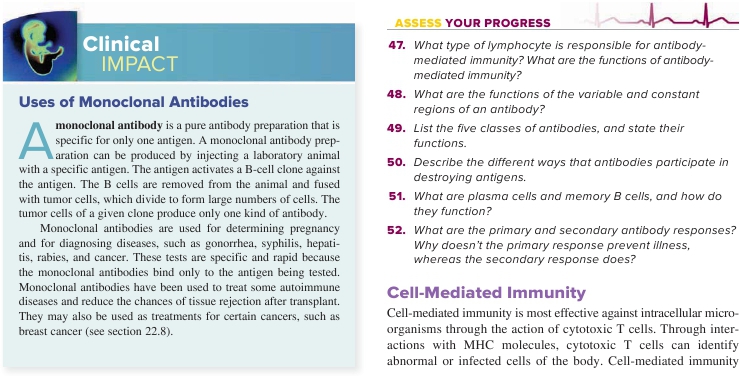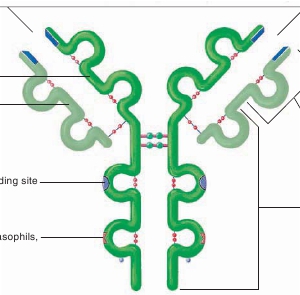CHAPTER 22 Lymphatic System and Immunity

805

Antigen-bindingsites
Heavy chain
Light chain
Variable regionsof light andheavy chains
FIGURE 22.19
Structure of an Antibody
Antibodies consist of two heavy and two lightpolypeptide chains. The variable region of theantibody binds to the antigen. The constantregion of the antibody can activate the classicalpathway of the complement cascade. The con-stant region can also attach the antibody to theplasma membrane of cells such as macrophages,basophils, and mast cells.
Complement-binding
Constant regionsof light andheavy chains
Site of binding tomacrophages, basophils,and mast cells
The
secondary response,
or
memory response,
occurs whenthe immune system is exposed to an antigen against which it hasalready produced a primary response. When exposed to the anti-gen, memory B cells rapidly divide to produce plasma cells, whichproduce large amounts of antibody. The secondary response pro-vides better protection than the primary response for two reasons:(1) The time required to start producing antibodies is less (hoursto a few days), and (2) the amount of antibody produced is muchlarger. As a consequence, the antigen is quickly destroyed, no dis-ease symptoms develop, and the person is immune.The secondary response also includes the formation of newmemory B cells, which protect against additional exposures to theantigen. Memory B cells are the basis for adaptive immunity.
After destruction of the antigen, plasma cells die, the antibodiesthey released are degraded, and antibody levels decline to thepoint at which they can no longer provide adequate protection.Memory B cells persist for many years—for life, in some cases.However, if memory cell production is not stimulated or if thememory B cells produced are short-lived, repeated infections ofthe same disease are possible. For example, the same cold viruscan cause the common cold more than once in the same person.
Predict 6
One theory for long-lasting immunity assumes that humans arecontinually exposed to the disease-causing agent. Explain how thisexposure can produce lifelong immunity.